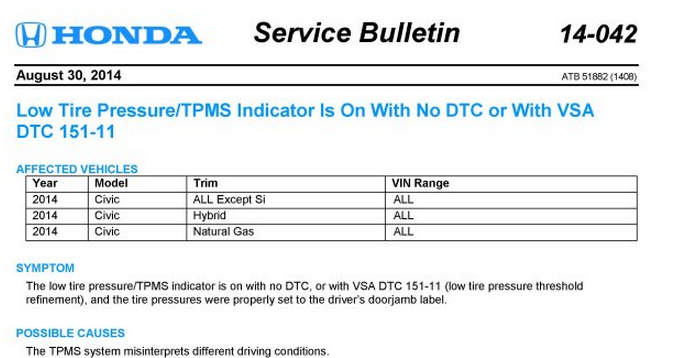Tire pressure monitoring system technology isn’t “new” in the sense that some form of TPMS has been around since the mid 2000s, but these systems are still evolving as manufacturers update their functionality and work out kinks discovered over time. Here are some of the most recent technical service bulletins issued by OEs concerning TPMS — ranging from reflashes to tire filling recommendations — that you need to know.
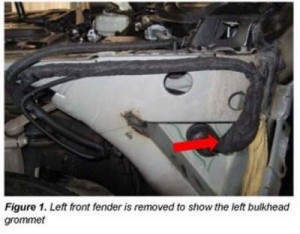
Audi: ABS Warning Light and Additional Warning Lights
Models:
2009-’13 A4/S4
2008-’13 A5/S5
2010-’13 A5/S5 Cabriolet
2009-’13 Q5
Customers may come in with one of the following conditions:
• Steering wheel does not lock.
• Various warning lights are on.
• Steering feels stiffer than usual.
• The engine cannot be switched off.
• The ignition key cannot be removed.
These vehicles use an indirect system and calculate tire pressure with the wheel speed sensors.
This TSB notes that the insulation for the ABS wheel speed sensor was damaged in production. Over time, this can lead to corrosion on the wires and restricted functions with the ABS control module.
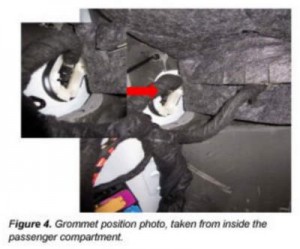
Only the wires in the left bulkhead grommet are affected.
There are DTCs present in the system, static or sporadic, such as:
• DTCs with the description “Brake Control Module – No Signal/Communication” are present in several control units.
• 01316 (Brake Control Module – No Signal/Communication)
• U012200 (ESP – No Signal/Communication)
• U012100 (ABS Control Module – No Communication).
Audi lists two different service actions depending on which DTCs are present. For vehicles with DTC “Brake Control Module – No Signal/ Communication” present in several control units, the TSB recommends inspection 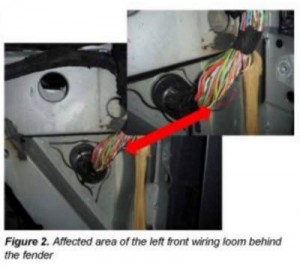 of the fuses and a voltage drop test with a load on specific pins to detect the damage at the grommet before you have to start removing parts.
of the fuses and a voltage drop test with a load on specific pins to detect the damage at the grommet before you have to start removing parts.
For vehicles with DTC description “ABS Wheel Speed Sensor – Incorrect Signal or Electrical Fault in Circuit” present in multiple control units, Audi recommends an additional voltage drop test to detect damage in the wiring for the wheel speed sensors.
Audi calls for repairing the wiring harness. Audi advises pulling back the insulation for the complete wiring loom, for a distance of about 40 cm from the grommet toward the front of the vehicle, and inspect for additional damage or corrosion.
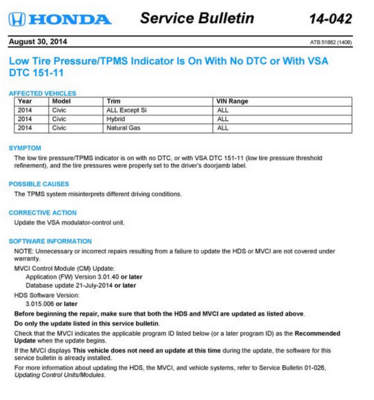 Honda: Low Tire Pressure Indicator With No DTC
Honda: Low Tire Pressure Indicator With No DTC
Models: 2014 Civic
This vehicle is producing a low tire pressure/TPMS indicator with no DTC or with VSA DTC 151-11 (Low Tire Pressure Threshold Refinement), even though the tire pressures are properly set to the driver’s doorjamb label. The probable cause is the TPMS misinterpreting different driving conditions.
The corrective action is a reflash — an update of the VSA modulator-control unit. Version 3.01.40 or later and HDS Software Version: 3.015.006 or later have the updated TPMS calibrations.
Once the update is complete, follow the on-screen prompts to turn the ignition to off, then to on again when indicated.
Using a factory or enhanced scan tool, go to the correct menu and start the VSA Sensor Neutral Position Memorization Procedure to calibrate steering angle sensors.
Special TPMS Calibration Used Only After Software Update:
If the tire pressures were not already set, set them to the cold inflation values listed on the driver’s doorjamb label.
1. Press the MENU button on the steering wheel to enter the customize settings.
2. Press the AUDIO REMOTE + or – button to select Customize Settings.
3. Press the AUDIO REMOTE + or – button to select TPMS Calibration.
4. Press the AUDIO REMOTE + or – button to select Initialize.
5. TPMS calibration will be initiated, would you like to proceed? Select Yes.
6. When the calibration begins, TPMS Calibration Has Been Initialized appears on the i-MID driver interface in the center console; when the system calibration is complete, the screen returns to TPMS Calibration.
7. Repeat steps 1 through 6 two more times.
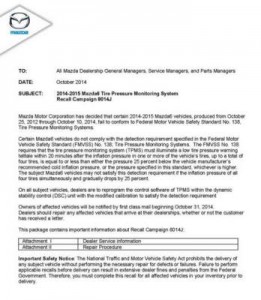 Mazda: TPMS Reflash for Certain Mazda6 Vehicles
Mazda: TPMS Reflash for Certain Mazda6 Vehicles
Mazda Motor Corp. decided that certain 2014-’15 Mazda6 vehicles failed to conform to the Federal Motor Vehicle Safety Standard (No. 138) concerning TPMS.
This standard requires the TPMS to illuminate a low tire pressure warning signal within 20 minutes after a tire’s inflation pressure is equal to or less than either the pressure 25% below the manufacturer’s recommended tire pressure or the pressure specified in the standard.
Mazda reported that the Mazda6 produced from Oct. 25, 2012, to Oct. 10, 2014, might not meet the detection requirements if the inflation pressure of all four tires simultaneously and gradually drops by 25%.
On these vehicles, the control software of the TPMS within the dynamic stability control unit needs to be reflashed with the modified calibration to satisfy the detection requirement.
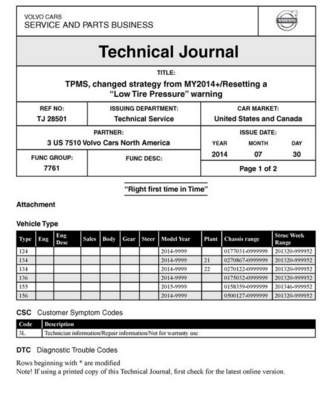 Volvo: New Low Pressure Strategy Introduced
Volvo: New Low Pressure Strategy Introduced
Volvo updated its low pressure warning algorithm starting in model year 2014 to account for temperature-induced tire pressure fluctuations.
When a car is driven for awhile, the temperature of its tires increases, and warmer tires have a slightly increased tire pressure. The new algorithm from Volvo changes the strategy of the TPMS to account for temperature pressure value.
The company noted in the bulletin that the new strategy may result in a situation where the TPMS warning does not extinguish when the tires are set to the specified pressure.
The owner’s manual now includes information that the recommended tire pressure be based on cold temperature, but the model year 2015 manual will include a clarification regarding the temperature-compensated pressure value.
Service: Volvo now prefers air to be put in tires when the vehicle has been parked for at least three hours — when the tire temperatures equal the ambient temperature. Tires can then be filled up to recommended cold tire pressure according to the owner’s manual.
If air is being put in a recently driven warm tire, the tire might need to be filled to 2-4 psi above the recommended cold tire pressure in order to switch off the low tire pressure warning.

